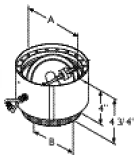Okay, we followed Elk's advice and thoroughly inspected and cleaned our stove top to bottom, blew out ash from baffle before firing up last week. Nothing warped or cracked. Checked gaskets and replaced the door gasket. Found one bolt loose on the stovepipe adaptor which is rear vented. Went to tighten and the bolt broke. Replaced with new and applied a bead of cement where the adaptor meets the stove opening. Then we removed the top and applied dabs of cement at each corner to fill in voids and hairline cracks in factory cement. Put top back on making sure square and level and tightened screws.
Compared to last year, the usual load is burning off much sooner and flames are moving much faster and are way more turbulent than before with air turned all the way down. Don't seem to be getting as much heat out of her. This was same on 20F day and 50F day. Could it be that we have a lot more draft since sealing the stove pipe adaptor? Checked for air leaks by looking for shiny black spots around door and top and found none. Door glass is super clean where we used to get a little brown in the bottom corners. Maybe something else to check? Do you think a damper is in order?
Whaddya think?
Details: rear vented Jotul F3CB, 4 feet double wall stove pipe, 45 elbow, through wall to Class A tee and 19 ft. of Class A outside wall. Burning red oak split and seasoned for 1.5 years.
Compared to last year, the usual load is burning off much sooner and flames are moving much faster and are way more turbulent than before with air turned all the way down. Don't seem to be getting as much heat out of her. This was same on 20F day and 50F day. Could it be that we have a lot more draft since sealing the stove pipe adaptor? Checked for air leaks by looking for shiny black spots around door and top and found none. Door glass is super clean where we used to get a little brown in the bottom corners. Maybe something else to check? Do you think a damper is in order?
Whaddya think?
Details: rear vented Jotul F3CB, 4 feet double wall stove pipe, 45 elbow, through wall to Class A tee and 19 ft. of Class A outside wall. Burning red oak split and seasoned for 1.5 years.


 .
.